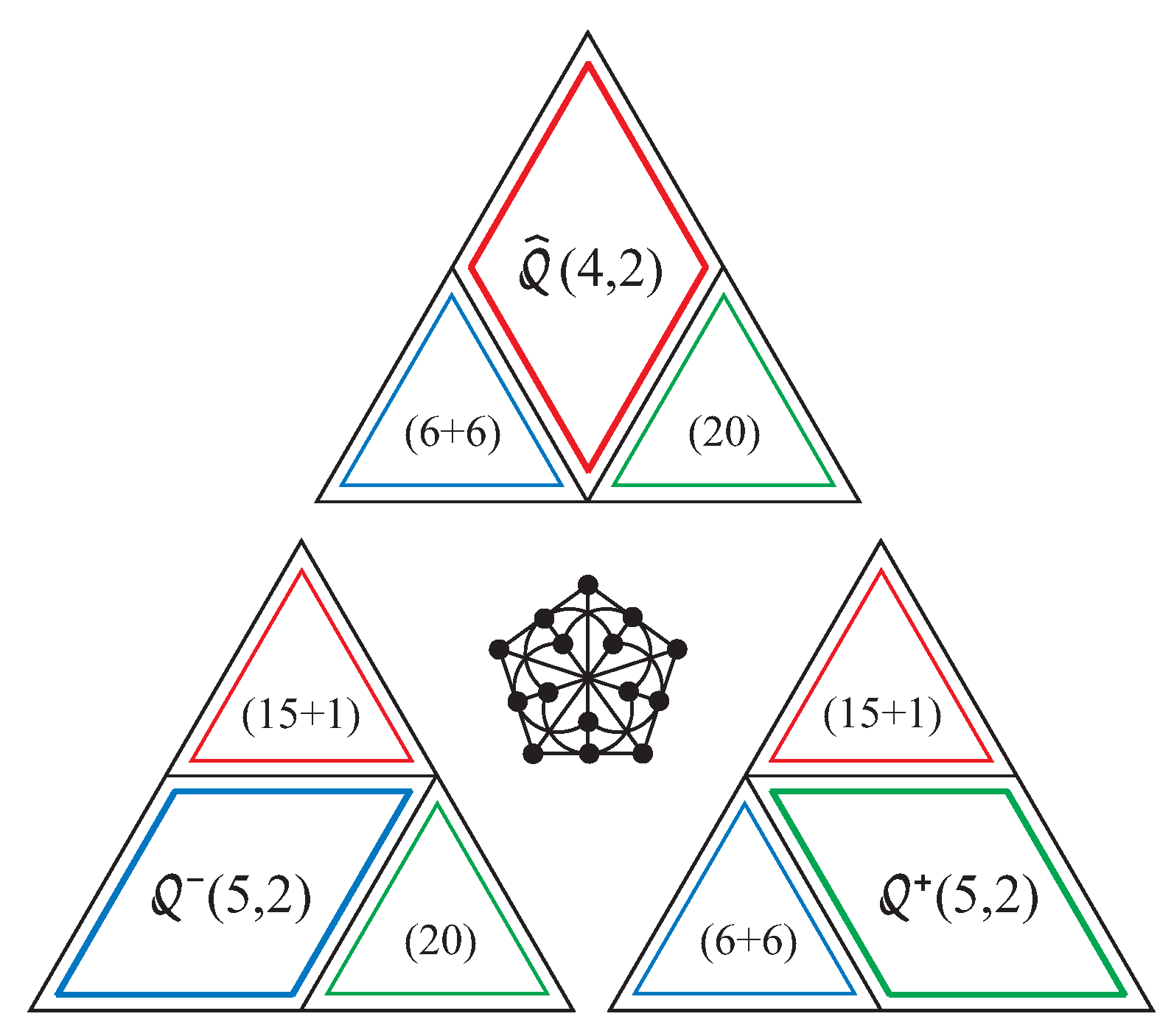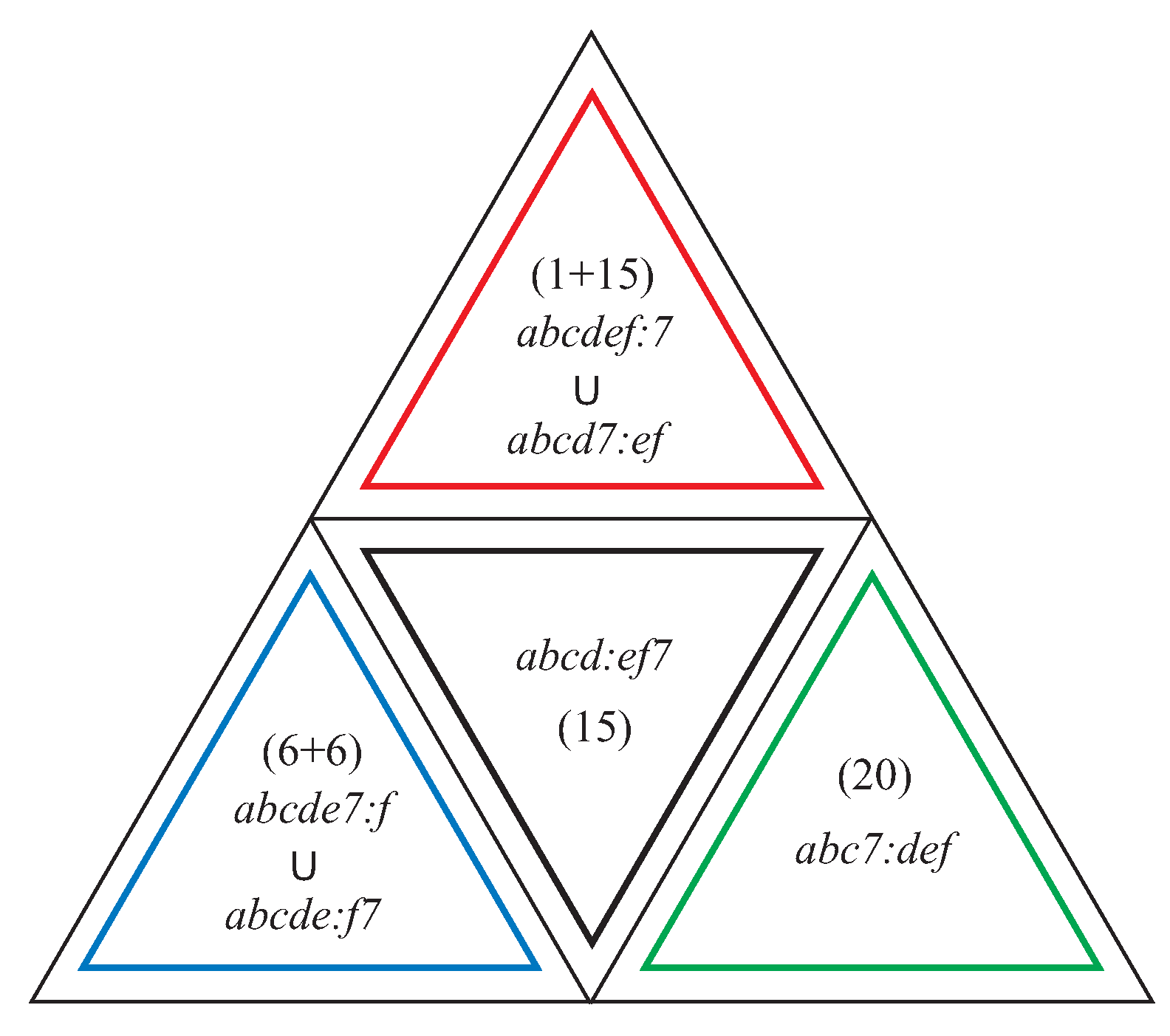A Combinatorial Grassmannian Representation of the Magic Three-Qubit Veldkamp Line
Abstract
:1. Introduction
2. Relevant Finite-Geometrical Background
3. Veldkamp Space of
4. Magic Three-Qubit Veldkamp Line in
- Core GQ(2, 2): Its 15 points are represented by those -points that share one digit in the second set; that is, by points whose representatives are : if the common digit is “7”; its 15 lines are those of type of the following particular form
- (5, 2) ≅ GQ(2, 4): The 12 additional points (the double-six) are represented by six -points of the form : and six -points of the form :f; the 30 additional lines lie in the -orbit, being of the (complementary) form
- (5, 2) ≡(5, 2): The 20 additional points are represented by -points of the form :; the 90 additional lines, belonging to the -orbit, read
- (4, 2): The 16 additional points are represented by 15 -points of the form : and a single -point :7 (the vertex of the cone); the 15 additional lines are located in the -orbit, having the form
5. Conclusions
Acknowledgments
Conflicts of Interest
References
- Lévay, P.; Szabó, Zs. Mermin pentagrams arising from Veldkamp lines for three qubits. J. Phys. A Math. Theor. 2017, 50, 095201. [Google Scholar] [CrossRef]
- Lévay, P.; Holweck, F.; Saniga, M. Magic three-qubit Veldkamp line: A finite geometric underpinning for form theories of gravity and black hole entropy. Phys. Rev. D 2017, 96, 026018. [Google Scholar] [CrossRef]
- Vrana, P.; Lévay, P. The Veldkamp space of multiple qubits. J. Phys. A Math. Theor. 2010, 43, 125303. [Google Scholar] [CrossRef]
- Saniga, M.; Planat, M.; Pracna, P.; Havlicek, H. The Veldkamp space of two-qubits. SIGMA 2007, 3, 075. [Google Scholar] [CrossRef]
- Mermin, N.D. Hidden variables and the two theorems of John Bell. Rev. Mod. Phys. 1993, 65, 803–815. [Google Scholar] [CrossRef]
- Shult, E.E. Points and Lines: Characterizing the Classical Geometries; Springer: Berlin/Heidelberg, Germany, 2011. [Google Scholar]
- Grünbaum, B. Configurations of Points and Lines; American Mathematical Society: Providence, RI, USA, 2009. [Google Scholar]
- Buekenhout, F.; Cohen, A.M. The Veldkamp space. In Diagram Geometry: Related to Classical Groups and Buildings; Springer: Berlin/Heidelberg, Germany, 2013. [Google Scholar]
- Prażmowska, M. Multiple perspectives and generalizations of the Desargues configuration. Demonstr. Math. 2006, 39, 887–906. [Google Scholar]
- Prażmowska, M.; Prażmowski, K. Some generalization of Desargues and Veronese configurations. Serdica Math. J. 2006, 32, 185–208. [Google Scholar]
- Saniga, M.; Holweck, F.; Pracna, P. From Cayley–Dickson algebras to combinatorial Grassmannians. Mathematics 2015, 3, 1192–1221. [Google Scholar] [CrossRef]
- Hirschfeld, J.W.P.; Thas, J.A. General Galois Geometries; Oxford University Press: Oxford, UK, 1991. [Google Scholar]
- Cameron, P.J. Projective and Polar Spaces. Available online: ftp://nozdr.ru/biblio/kolxo3/M/MD/Cameron%20P.J.%20Projective%20and%20polar%20spaces%20%28lecture%20notes,%20web%20draft,%202000%29%28182s%29_MD_.pdf (accessed on 18 October 2017).
- Thas, J.A. Maximal exterior sets of hyperbolic quadrics: The complete classification. J. Combin. Theory A 1991, 56, 303–308. [Google Scholar] [CrossRef]
- Conwell, G.M. The 3-space PG(3, 2) and its group. Ann. Math. 1910, 11, 60–76. [Google Scholar] [CrossRef]
- Payne, S.E.; Thas, J.A. Finite Generalized Quadrangles; Pitman: Boston, MA, USA, 1984. [Google Scholar]
- Saniga, M. The complement of binary Klein quadric as a combinatorial Grassmannian. Mathematics 2015, 3, 481–486. [Google Scholar] [CrossRef]
- Lévay, P.; Saniga, M.; Vrana, P.; Pracna, P. Black hole entropy and finite geometry. Phys. Rev. D 2009, 79. [Google Scholar] [CrossRef]


| Type | Form | Geometrical Constituents | Number |
|---|---|---|---|
| : | Pasch configuration and its complementary line | 35 | |
| : | Desargues configuration and its complementary point | 21 | |
| :g | Cayley–Salmon configuration | 7 |
| Type | Form | Core Composition | Number |
|---|---|---|---|
| : | |||
| : | three mutually non-collinear points (, , and ) | 105 | |
| : | |||
| : | |||
| : | a line () and a point () | 210 | |
| : | |||
| : | |||
| : | two disjoint lines ( and ) | 70 | |
| :g | |||
| : | |||
| : | a line () and two non-collinear points ( and ) | 105 | |
| : | |||
| : | |||
| : | a Pasch configuration () and a point () | 105 | |
| :e | |||
| : | |||
| : | a Pasch configuration () | 35 | |
| : | |||
| : | |||
| :g | a Desargues configuration () | 21 | |
| :f |
© 2017 by the author. Licensee MDPI, Basel, Switzerland. This article is an open access article distributed under the terms and conditions of the Creative Commons Attribution (CC BY) license (http://creativecommons.org/licenses/by/4.0/).
Share and Cite
Saniga, M. A Combinatorial Grassmannian Representation of the Magic Three-Qubit Veldkamp Line. Entropy 2017, 19, 556. https://doi.org/10.3390/e19100556
Saniga M. A Combinatorial Grassmannian Representation of the Magic Three-Qubit Veldkamp Line. Entropy. 2017; 19(10):556. https://doi.org/10.3390/e19100556
Chicago/Turabian StyleSaniga, Metod. 2017. "A Combinatorial Grassmannian Representation of the Magic Three-Qubit Veldkamp Line" Entropy 19, no. 10: 556. https://doi.org/10.3390/e19100556





